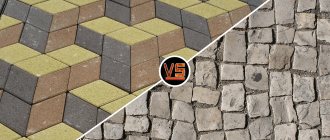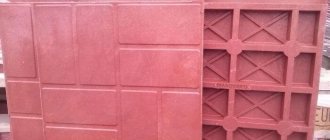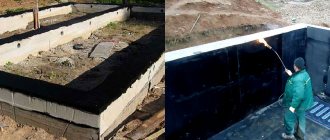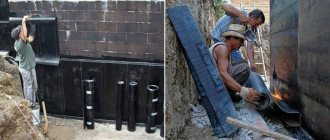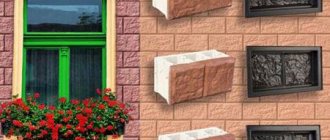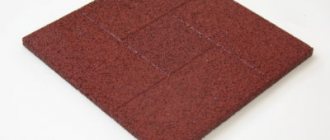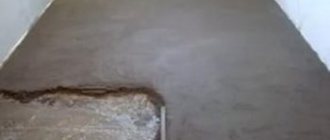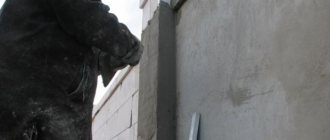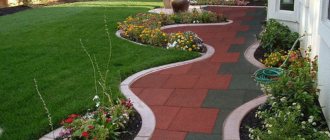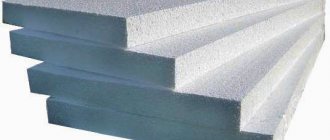HAUBERK facade tiles not only give a beautiful appearance, but also provide excellent protection against most external influences. A facade covered with such tiles is resistant to all types of precipitation, mechanical stress, and ultraviolet radiation. The original color of HAUBERK facade tiles from TechnoNIKOL remains unchanged throughout its entire service life.
Surely many developers have not yet resolved the issue of choosing a facing material. Consider using flexible facade tiles from HAUBERK, because there is every reason for this. TPK "Metal Roofing Center" will help you with your choice.
Components for the production of concrete tiles
It includes:
- cement;
- sand;
- mineral powder - a cement substitute made from ash, ground slag, stone crushing waste, etc., introduced into concrete in a volume of 5-20% to give the concrete special properties (heat resistance, different colors, etc.);
- plasticizing additives - used to increase the mobility of the concrete mixture;
- stabilizing additives - to prevent separation of the concrete mixture;
- water-retaining additives - to reduce water separation.
To achieve good quality cladding of façade walls, it is necessary that they be smooth
Manufacturing technology for concrete façade tiles
The main method for producing facade concrete tiles with low porosity is vibration casting. The prepared concrete mixture is placed in plastic forms mounted on a vibrating table and completely compacted under the influence of high frequency vibration. Then the plastic forms are transferred to racks, covered with plastic film to prevent moisture loss and kept for a day. Next, the finished tiles are removed from the plastic molds and transported to the warehouse.
Painting of façade concrete tiles for dry laying is carried out during their manufacture
Using this technology, it is possible to obtain tiles with both matte and glossy surfaces, without pores or other defects. The use of high-quality coloring pigments makes it possible to obtain tiles painted in rich colors that do not lose their brightness for many years. You can read the material about clinker facade tiles.
The quality of the glossy surface and the relief of facade concrete tiles is determined by the surface relief of plastic forms.
Price
Below are prices for facade tiles of domestic and European production.
Price for tiles produced by Kerama Marazzi (Russia):
| Facade collection | Price, rub.) |
| Rock garden | 961 |
| Rubicon | 394 |
| Abington | 1 043 |
- Location:
st. Milashenkova 1/1, Moscow - Call here:
(495) 72 375 79 - Find out more:
plitkaoboi.ru
Price of popular series of facade tiles made of clinker and porcelain stoneware.
| Manufacturer/Series | Price RUR/m2 |
| Opoczno (Poland)/Shadow Brown | 1 121 |
| Meissen Keramik (Germany)/Arkos | 2 702 |
| Tubadzin (Poland)/Travertin | 1 638 |
- Location:
st. Repina 95, Ekaterinburg - Call here:
(343) 23 231 26 - Find out more:
stroicafe.ru
Advantages and disadvantages of concrete facade tiles
All building materials have both advantages and disadvantages.
The quality of the glossy surface and the relief of facade concrete tiles is determined by the surface relief of plastic forms
The advantages of concrete tiles include:
- the mass of facade tiles is relatively light, which not only reduces the load on the structure of the structure, but also makes it possible to implement exterior finishing on your own;
- it is similar to stone, not only visually, but the natural aging process of these materials is also practically indistinguishable in appearance;
- Since the surface of the tile is hard, it withstands the effects of precipitation well and is resistant to mechanical damage, i.e. will serve for a long time if installed correctly and timely maintenance;
- To attach concrete tiles, you do not need a special spacer layer; they can be mounted on walls made of various materials that adhere well to adhesives.
- Concrete façade tiles are cut with a simple chisel (cutter), although cutting with a circular saw produces less labor and better results.
The main method of manufacturing facade concrete tiles with low porosity is vibration casting
However, concrete tiles also have disadvantages:
- It is better not to use this tile in cold climates, since not all manufacturers guarantee the stability of its properties in the presence of freeze/thaw cycles;
- Sometimes, even during the normal manufacturing process, the edge of a concrete tile is uneven or an unnecessary edge is formed on its edges. And although they can be easily removed with a circular saw or cutter, installation labor costs increase.
The dry method is intended for tiling brick, concrete and wooden surfaces without the use of any adhesives or mortars
Building facade with ventilated system
Detailed instructions for laying ceramic tiles on facades with ventilation. It is worth noting that in this case, ceramic tiles are no different from other materials used in the work. The procedure is pretty standard:
- The first step is to secure the brackets to the wall. Horizontally - it is necessary to take into account the total width of the tile and the seam, and in the vertical direction - no more than 8 centimeters.
- It is best to fix the insulation and wind barrier system to the wall using fungi.
- Then you need to assemble the frame base of the ventilation façade itself. First, it is better to mount vertical type profiles, and then horizontal ones.
- The finish is secured using clamps or special slides.
- Of course, each of the profiles is distributed at a certain angle and edges all the openings of windows and doors in the building:
Dry method of installing concrete facade tiles
There are two ways to attach tiles that you can use when installing them yourself. The dry fastening method involves the use of special facade tiles recommended for this method. You can learn about modern types of finishing of house facades.
Important! The dry method is intended for tiling brick, concrete and wooden surfaces without the use of any adhesives or mortars. Among other things, the work described can be done at any time of the year.
The tiles are attached to the surfaces of concrete or brick facades with dowels and nails. Tiles are attached to log and plank walls and frames, as well as those made of timber, using self-tapping wood screws.
Facade concrete tiles are an excellent architectural and construction solution used for cladding finished buildings of various types and purposes.
If you plan to install the tiles yourself, it is best to choose this method of cladding. Firstly, such cladding can imitate various types of stone and brickwork. However, unlike facing bricks, concrete facade tiles will be significantly cheaper, you can fix them quickly and easily, and the coating will look no worse.
Painting of façade concrete tiles for dry laying is carried out during their manufacture. In this case, the product is painted completely throughout its volume, and not just on the outer surfaces. Therefore, fading of colored concrete tiles under the influence of ultraviolet radiation is excluded.
These tiles can have almost any color:
- plain;
- iridescent;
- imitating the surface of granite, marble, malachite, amber, etc.
Documents that comply with legal regulations
Since 1995, all ceramic products for facade cladding have been manufactured in accordance with GOST 13996-93. The following qualities are regulated:
- The shape of the produced tiles for facades must be exclusively square or rectangular.
- The thickness of the product is only 7 or 9 mm.
- The dimensions of the tiles are clearly regulated and should not exceed the limits of 50 * 50 - 300 * 150 mm.
- 2 mm or 0.75 percent is the permissible curvature of the material.
- The depth of the notch on the inside of the product, the width of the seam during installation work and the permissible curvature of the corner of the tile carpet are also clearly indicated.
It is worth noting that the price for each product is set directly by the manufacturer, depending on the material, color and texture features.
Finishing the facade with ceramic tiles in the form of a bright pattern on the panel
Wet method of installing concrete facade tiles
To achieve good quality cladding of façade walls, it is necessary that they be smooth. If there are irregularities, it is recommended to plaster the walls.
The installation process includes the following steps:
- Before installing the tiles, the surfaces of the facade walls and the back sides of the tiles should be moistened with water using a paint brush.
- The façade should be faced starting from the plinth, which is the base of the facade walls of the house and creates a transition to the areas of the earth’s surface adjacent to the house - sidewalk, driveway, lawn. It is better to make the color of the plinth cladding darker than that of the wall cladding, then it will look more monumental. In order to maintain the same level along the entire perimeter of the house when covering the base, a starting strip is nailed at the bottom of the base, which is strictly set according to the level (preferably a laser level). It is on the starting bar that the first row of tiles is laid out. Install the tiles starting from the corners from bottom to top.
- To apply a 0.5 cm layer of tile adhesive to the surface of the walls, use a smooth spatula. Next, level the glue with a notched trowel with teeth 4–6 mm high.
- A 0.4–0.6 cm layer of adhesive is applied to the back of the tiles with a notched trowel.
- Next, using gentle movements and turns, the tiles are pressed against the wall surface until the glue comes out at the joints between the tiles.
Correct and professional execution of wall cladding will significantly extend the life of the house façade. Therefore, before you start installing facade tiles, study the technology of this work, or better yet, watch it with your own eyes or at least on a video on the Internet.
Comments
0 Natalia 10/14/2015 10:03 On the contrary, I really like this tile.
It looks beautiful, neat and cozy. And of course, the price is attractive, although in order to cover the entire house with concrete tiles, you will have to spend a lot of money. Just recently, her husband was sheathing a house to order for her and said that such tiles were very easy to install. Quote
-1 Sasha 12/26/2014 17:43 To be honest, I don’t like the look of concrete tiles, it looks too cheap, but that’s just my opinion, others, of course, may think differently, but I don’t see anything attractive except the price. She's really good here in my opinion.
Quote
Update list of comments RSS feed of comments for this entry
What is elastic or highly elastic adhesive?
The elasticity of cementitious adhesives is determined according to the EN 12002 standard. This standard describes a test method that measures the deformability of the adhesive using a bending test (a sample of the adhesive film is subjected to a central load). The higher the deformability of the adhesive, the greater the deflection measured at the center of the sample.
The standard defines two elasticity classes. Class S1 identifies "elastic adhesives" for which the deflection size is 2.5-5 mm, while class S2 identifies "highly elastic adhesives" for which deflection is ≥ 5 mm.
